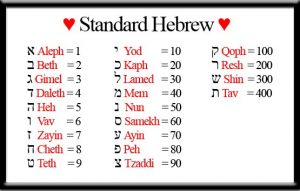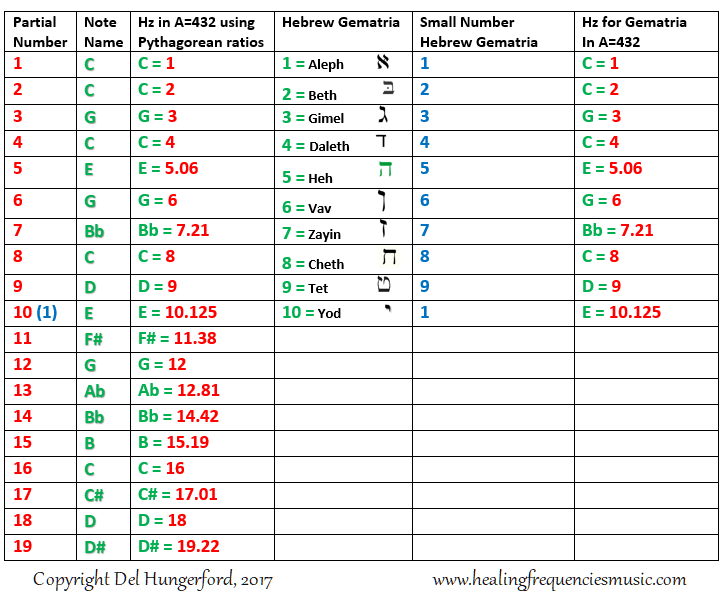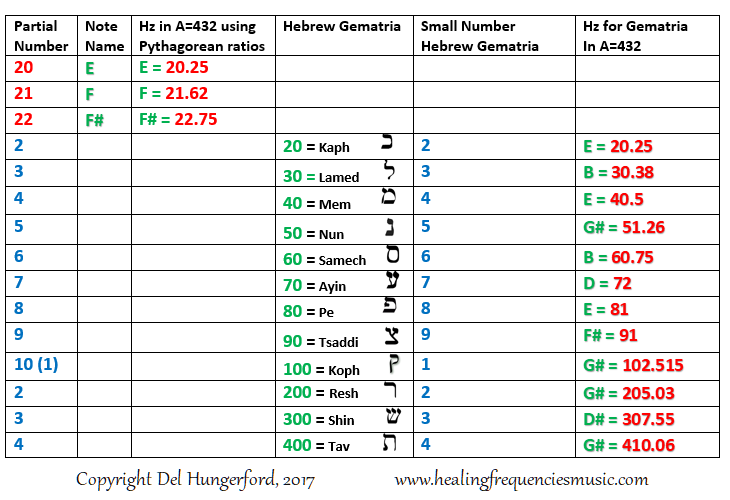Have you ever been on one of those missions where you are so close but so far? It’s been almost a year since my last post about the harmonic series. The goal has been to find a connection between Hebrew gematria and musical frequencies. With this post, I propose that I’ve found a plausible connection! The original post is titled “Overtones and A=432.” In that article, I mainly discuss the overtone series and what it is, followed by a couple of charts where I compare the overtones to actual pitches.
I’ve found a couple videos where others do a great job of explaining how the harmonic series works. If you need a refresher, these should help. In order to discuss my connection (as mentioned above), you may want a refresher on the harmonic series. Here’s one of the famous conductor/composer, Leonard Bernstein. If you don’t know who Leonard Bernstein is, to help jog your memory, he composed “West Side Story.”
Here’s a quick sample of what the harmonic series actually sounds like with a wonderful visual on how it looks on a string. The still picture from this video has been circulating around Facebook with the subject line having something to do with cymatics.
In this next video, you get a bit more information why musical instruments have their own sound. Timbre is how you can tell the difference between the various sounds you hear, including the voices of the people you recognize. When you hear a familiar voice, you know who that person is without looking because his/her voice is unique to him/her. It’s the same with musical instruments – each instrument has a sound that’s specific to that instrument. For example, a trumpet doesn’t sound like a piano because their timbres are different.
Every person has a unique “voice print,” as I’ve heard described by some. Your voice sounds like no one else’s. It all has to do with which harmonics are present as well as which ones are absent. Plainly said – we each have a unique voice code just like we each have different DNA.
NOTE: The pitches given in this video reflect the A=440 concert pitch.
What does any of this have to do with the Hebrew gematria? Understanding the harmonic (overtone) series is important before this next bit can be explored. After a year of searching, I believe that I’ve found a connection (pattern) between the overtone series and the Hebrew alphabet. When comparing gematria with musical pitches, there has to be patterns somewhere built into the system. Why? Because everything in music (as well as nature) is based on patterns. You don’t see a pattern? Then, keep looking until you do!
 The Hebrew alphabet, called the “Aleph-bet,” comes with numbers assigned to each letter. Depending on which version of gematria used, the numbers will change. The image to the left shows the standard method of Hebrew gematria. To find the numerical value for a Hebrew word, you add up the numerical value of each letter in that word. For example, the name of God is Yod (10) – Heh (5) – Vav (6) – Heh (5) which is a sum total of 26. Therefore, the gematria for the name of God is 26. It will be different in other forms of gematria.
The Hebrew alphabet, called the “Aleph-bet,” comes with numbers assigned to each letter. Depending on which version of gematria used, the numbers will change. The image to the left shows the standard method of Hebrew gematria. To find the numerical value for a Hebrew word, you add up the numerical value of each letter in that word. For example, the name of God is Yod (10) – Heh (5) – Vav (6) – Heh (5) which is a sum total of 26. Therefore, the gematria for the name of God is 26. It will be different in other forms of gematria.
After researching a variety of gematria methods, checking for musical patterns, I came upon one called “Mispar Katan” or “small number.” After passing over it several times, I finally came back to it once I realized that the harmonic series perfectly lines up with it. I found my pattern! Now, what to do with that? Most of that information will come out as I dig deeper into the wonderful world of numbers, gematria, nature, and music.
What I find extremely fascinating about the harmonic series and the Mispar Katan gematria… When assigning gematria numbers a frequency (a gematria number = a note/frequency), everything fits into the A=432 concert pitch (with slight variations). Take a look at this chart that I put together for your viewing pleasure.
- COLUMN 1: “Partial Number” refers to the harmonic/overtone series where each partial is assigned a number from 1 until infinity. In this chart, it only goes up to the 22nd partial. Musical harmonics are in red.
- COLUMN 2: Note names are in green
- COLUMN 3: The Hertz (Hz) are listed in red with actual note names in green. For example – 1=C, 2=C (an octave higher), 3=G, 4=C (even higher than the previous C), etc.
- COLUMN 4: Each Hebrew letter name/symbol is listed along with the standard gematria in green.
- COLUMN 5: The “Mispar Katan” (small number) method of gematria and overtone/harmonic partials (which are identical) are in blue.
- COLUMN 6: The note names according the Hebrew gematria, are in green followed by the Hz in red.
Musical Harmonics and Hebrew Gematria Chart


Some interesting items to note…
- Isn’t it fascinating that the actual partial number matches the frequency in Hertz (Hz)? And, it’s all in the A=432 concert pitch. Hmmmm….
- The Hz numbers are slightly different, in some cases. Depending on the temperament being used (equal temperament, well-temperament, just intonation, etc), these numbers will vary slightly.
- Notice how the Hebrew aleph-bet in the small number gematria continues to build a new harmonic series of ten pitches? The last partial (10) equals the first partial of the next series. In this example, the harmonic series starts on “C,” then starts again on “E,” and finally begins yet again on “G#.” What is the end is also the beginning, which is a Hebrew way of thinking.
- Study the chart and you’ll notice the similarities between the overtone numbers (partial) and the exact frequencies. For example, the number 1 IS the pitch “C” in the A=432 concert pitch. It’s lower than you can hear but it’s still a “C.” Number 1 also represents the gematria for the Aleph, Yod, and Koph. Lastly, it’s the first partial in the harmonic series. The next number is doubled (2), which is an octave (also a C). It keeps going up from there.
- There are many layers to almost everything. In this case, we have a layer of musical harmonics with musical pitches, and an ancient (maybe the most ancient?) alphabet. As noted above, there are many forms of gematria for the Hebrew language. This leads to the hypothesis…
Hypothesis
It’s possible that layering of patterns between musical harmonics, the actual pitches matching those harmonics, along with an ancient alphabet… it’s likened to the many-dimensional world we live in. Once we find the connection(s) between various patterns, the puzzle pieces begin to fit together. It’s also possible to determine the exact frequency of each Hebrew letter. But, that’s for another writing. One thing leads to another that leads to another… that leads to yet another. Yes, Alice, we are going down the rabbit hole. How about choosing between the red pill or the blue pill as described in “The Matrix?” The main point here? There’s a good trail to follow and although I’m not sure what the outcome will be, there’s enough evidence to suggest I’m on the right track.
There are many forms of Hebrew gematria. All have many layers and each has a specific purpose. After spending numerous hours listening to Rabbi’s talk about gematria, The Hebrew people see and “engage” their aleph-bet as a living entity. The goal is to actually engage with those letters because they are said to be the very breathe of HaShem (means “the name” but is used as a name for God). Several Rabbi’s even discussed how they believe HaShem created the whole universe through these letters. Want to have some fun? Google “Hebrew gematria” and have at it! There’s lots of great YouTube videos on gematria.
The small number Hebrew gematria closely aligns with patterns in music. In this article, it’s obvious that the harmonic series matches it as a repeated pattern of ten; ten also being the first partial of the next set. I believe it’s possible to determine the frequency (Hz) of Hebrew letters and words. I have an idea of what that will look like but you’ll have to wait for the next blog post for that information.
Some of my music is recorded (in part) because I’m fascinated by numbers. Try listening to Open Gates, which is based on the F-sharp major triad. This chord comes directly from numbers (turned into Hz) that match various shapes. Enjoy!
Enjoy going down the rabbit hole!
Del
Copyright, 2017 by Del Hungerford


Hello Del,
Love your articles! There is one correction; hashem literally means the name, it is not The Name of the Most High Elohim. His Name is Yahweh (Yod Heh Waw Heh – however one is lead to pronounce it).
With that said, Yahweh bless you!
josette
Thank you, Josette. I went back in and made the adjustment. Thank you for your patience until I had time to get to it.
I found your research and information on the connection between Hebrew gematria and musical tones/frequencies – VERY INTERESTING!
We (my family) use RIFE for healing – I’m not sure if you are familiar with what RIFE Is(?) but I am going to guess that you are.
if not – research Dr. Royal Rife – and Dr. Hulda Clark
Rife uses a combination of frequency generators and “profiles” that are based on the frequency of certain microbial-infections.
The scriptures state that “the life is in the blood” – so what we find is that all events through-out our lives – remain in our blood.
trauma: Sickness, a fall that causes a broken bone, a car wreck, rape – or any other kind of highly-emotionally charged event in life – is IMPRINTED into one’s blood!
RIFE – with a combination of prayer(s) – literally clears a person of the damage of such trauma —
There are numerous profiles that a community of RIFE users have created through experimentation —
these profiles have been proven over the years to correct DNA damage, problems with diabetes, physical and mental disorders – and much more!
They do this with FREQUENCIES — using both touch (wires connected to metal/copper tubes – and PLASMA LAMPS –
I myself was diagnosed with the onset of diabetes
a couple of overnight sessions with RIFE and I had no sign of any diabetic issues.
There is – I believe – a connection with these technologies, the LIVING WORD OF GOD (not just the Bible – but what God says AND Jesus christ, the only begotten son) and your work that you have presented here.
I would very much like to speak with you.
I’d also like your permission – to use and quote from your writing here.
THE LORD BLESS YOU AND KEEP YOU!
David Beverley Sr.
Thank you, David. Yes, I’m very familiar with Royal Raymond Rife. You’ll find that I’ve written two blog posts about him and his work. There’s a group called Novabiotronics that’s using Rife technology to kill cancer. You might want to check that out, too!